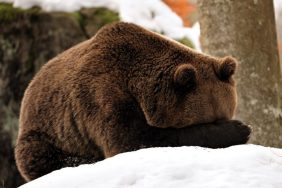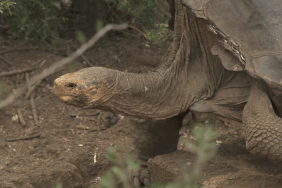Photo: Pieter Hugo, Jatto with Mainasara, Ogere-Remo, Nigeria, 2007, Digital C-Print, © Pieter Hugo, courtesy Yossi Milo Gallery, New York.
When the Panama Canal opened in 1914, San Diego became the first U.S. port of call for ships traveling north after passing westward through the canal. To launch the city on the world stage, the Panama-California Exposition was held from January 1, 1915–January 1, 1917, with 1,400 acres of Balboa Park dedicated to displays. Exotic animals were displayed, with peacocks and pheasants roaming freely across the grounds. When the exposition was finished, the animals were abandoned. The city partnered with Dr. Harry M. Wegeforth, founder of the Zoological Society of San Diego to create the San Diego Zoo in 1916.
Also: Holy Cow! “Sightings of the Sacred” is Divine
Dr. Wegeforth took a new approach to zoo keeping, pioneering a “cageless” approach by using open-air grotto exhibits surrounded by moats to separate the animals from the visitors, launching one for bears in 1920, and one for lions in 1923. As the years progressed, the Zoo developed and advanced its approach to zoology and conservation, becoming one of the leading institutions worldwide in the study and preservation of animals.

Marie Cécile Thijs, Cat with White Collar V, 2015, Modern art print on Diasec. Courtesy of Stephanie Bergsma and Dwight Hare© Marie Cécile Thijs.
In honor the San Diego’s Zoo’s 100th anniversary, give prominent Balboa Park institutions are hosting animal-themed exhibitions throughout the year, providing a wide array of ways of exploring our relationships to the fauna of this planet. Among the exhibiting institutions are the San Diego History Center, the San Diego Natural History Museum, Timken, the San Diego Museum of Art, and the Museum of Photographic Arts, which presents Beauty and the Beast: The Animal in Photography, on view now through October 9, 2016.
Beauty and the Beast presents an examination of animals in photography, with works by a wide array of artists including Tom Chambers, Pieter Hugo, Kahn & Selesnick, Karen Knorr, and Marie Cécile Thijs, among others. The exhibition shows a myriad of ways in which animals have been depicted in photograph, whether anthropomorphized in portraiture, seen in situ in documentary work, or taken as metaphorical iconography for explorations in fine art.

Karen Knorr, The Grand Monkey Room 3, Chateau Chantilly, 2014. Pigment print. Courtesy of Becky Moores. © Karen Knorr.
Included in the show is a work South African photographer Pieter Hugo from his landmark book, The Hyena & Other Men, taken in Nigeria in 2007. It is a portrait of Jatto with Mainasara, a hyena who sports an ominous looking facemask that is attached to a massive chain link leash. Hugo’s photograph is as bold as it is seductive, a show of strength and power that speaks to man’s dominance over the natural world. Jatto is a member of the Gadawan Kura (loosely translated as “hyena handlers”), a group of street performers who use hyenas and baboons to entertain crowds and sell traditional medicines.
Each work chosen for Beauty and the Beast speaks to the deep, intricate, and complex relationship we share with all creatures on the earth. It is a wonderful reminder of the interconnectivity of life and an opportunity to reflect on what we, as guardians of the planet, are charged to protect and preserve in this life.

Tom Chambers, Saccharine Perch, 2009, courtesy of the artist.
Miss Rosen is a New York-based writer, curator, and brand strategist. There is nothing she adores so much as photography and books. A small part of her wishes she had a proper library, like in the game of Clue. Then she could blaze and write soliloquies to her in and out of print loves.







